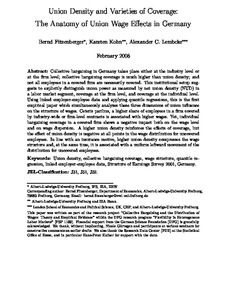Union density and varieties of coverage: the anatomy of union wage effects in Germany
"Collective bargaining in Germany takes place either at the industry level or at the firm level; collective bargaining coverage is much higher than union density; and not all employees in a covered firm are necessarily covered. This institutional setup suggests to explicitly distinguish union p...
| Main Authors: | , , |
|---|---|
| Institution: | ETUI-European Trade Union Institute |
| Format: | TEXT |
| Language: | English |
| Published: |
Mannheim
2008
ZEW |
| Subjects: | |
| Online Access: | https://www.labourline.org/KENTIKA-19189644124919078269-union-density-and-varieties-of.htm |
| Summary: | "Collective bargaining in Germany takes place either at the industry level or at the firm level; collective bargaining coverage is much higher than union density; and not all employees in a covered firm are necessarily covered. This institutional setup suggests to explicitly distinguish union power as measured by net union density (NUD) in a labor market segment, coverage at the firm level, and coverage at the individual level. Using linked employer-employee data and applying quantile regressions, this is the first empirical paper which simultaneously analyzes these three dimensions of union influence on the structure of wages. Ceteris paribus, a higher share of employees in a firm covered by industry-wide or firm-level contracts is associated with higher wages. Yet, individual bargaining coverage in a covered firm shows a negative impact both on the wage level and on wage dispersion. A higher union density reinforces the effects of coverage, but the effect of union density is negative at all points in the wage distribution for uncovered employees. In line with an insurance motive, higher union density compresses the wage structure and, at the same time, it is associated with a uniform leftward movement of the distribution for uncovered employees." |
|---|---|
| Physical Description: | 39 p. Digital |

